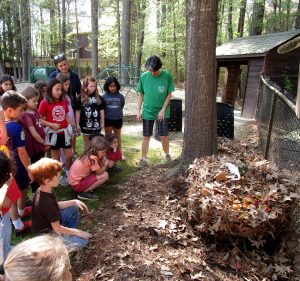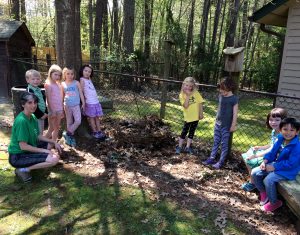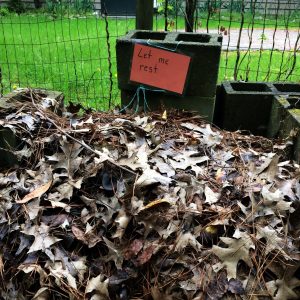Recipe for Dirt
By Shelly Lyons, Resource Teacher
 Being a resource teacher at MCS, I have many opportunities that I never had as a lower elementary classroom teacher. My favorite one is spending time with all of the students and teachers at our school. I love knowing everyone and seeing all of the different classes in action. I now have a much deeper, more complete understanding of Montessori education from 18 months up to 8th grade.
Being a resource teacher at MCS, I have many opportunities that I never had as a lower elementary classroom teacher. My favorite one is spending time with all of the students and teachers at our school. I love knowing everyone and seeing all of the different classes in action. I now have a much deeper, more complete understanding of Montessori education from 18 months up to 8th grade.
Another thing that I’ve had the time to do is ramp up our campus-wide composting. Care of the environment is an issue very close to my heart, as it was to Maria Montessori’s. First, I revived and helped balance some of the outdoor compost bins, which have been here for years. After I researched and found some functional and beautiful new metal compost bins, the school purchased one for each classroom. Then teachers made time for me to talk with their students about the importance of composting. The primary and lower elementary children were especially excited by the lessons and learning the “recipe for dirt”. After the lessons I had lots of students run up to me, eager to tell me what they’d added to the compost that day.
“Shelly, I put a banana peel in the compost today!”
 “We had crackers for snack and two of mine fell on the floor, so I put them in the compost!”
“We had crackers for snack and two of mine fell on the floor, so I put them in the compost!”
“I had an orange in my lunch and put the peels in!”
How rewarding to see their joy in helping the earth! A few days before the spring Garden Day I did some work with the outdoor compost bins again. I wanted students and teachers to be able to “harvest” our freshly made soil and add it to their gardens. The black plastic compost bin on the side primary playground came apart easily, as it’s made to do.
Once removed, we could see the layers of the compost. Elders and LE students came out with me to look at it in small groups. They observed the fluffy, recognizable things on the top; leaves, old cut flowers from their flower arrangements, banana peels, pear and apple cores, orange peels, and more. We could see the layers get more and more compressed as it went down. Some students were so excited to see the rich, black soil at the bottom, they grabbed small handfuls and exclaimed, “It really turns into dirt!!” There’s nothing like seeing the real thing to make a true believer.
 If you would like to start composting at home, here are some tips. Keep in mind that composting is a very natural process which the Earth has been doing forever without any help. You can make it as simple or as complicated as you want. Mine at home is extremely rustic and simple, but there are many options available to keep your outdoor compost pile neat, tidy and even attractive looking. Whether you actually use the compost you make or not, you are reducing your garbage and every little thing we do helps and makes a difference on the planet.
If you would like to start composting at home, here are some tips. Keep in mind that composting is a very natural process which the Earth has been doing forever without any help. You can make it as simple or as complicated as you want. Mine at home is extremely rustic and simple, but there are many options available to keep your outdoor compost pile neat, tidy and even attractive looking. Whether you actually use the compost you make or not, you are reducing your garbage and every little thing we do helps and makes a difference on the planet.
Recipe for dirt
All composting requires four basic ingredients:
Browns — somewhat dry materials such as dead leaves, pine needles, sawdust, twigs, dryer lint, and eggshells. These are high in carbon and are a source of energy for the compost microbes.
 Greens— wetter materials such as grass clippings, vegetable and fruit scraps, tea bags, coffee grounds, and manure. Greens are materials that are rich in nitrogen or protein. These heat up a compost pile because they help the microorganisms in the pile grow and multiply quickly.
Greens— wetter materials such as grass clippings, vegetable and fruit scraps, tea bags, coffee grounds, and manure. Greens are materials that are rich in nitrogen or protein. These heat up a compost pile because they help the microorganisms in the pile grow and multiply quickly.
Air — (Which is why things in plastic bags buried in a landfill often don’t decompose.)
Finally, decomposers (worms, insects, grubs, microorganisms, etc) are crucial to the process, but since they occur naturally, they aren’t a part of the recipe.
Here’s one possible link to get you started:
https://www.planetnatural.com/composting-101/getting-started/
The compost bins classrooms use are the Utopia Kitchen Stainless Steel Compost Bin for Kitchen Countertop, 1.3 gallons.
